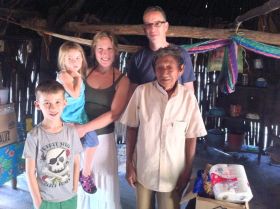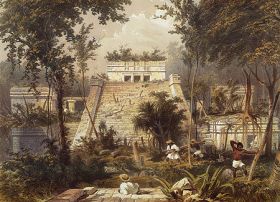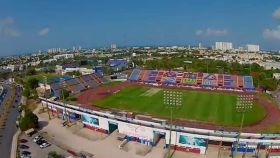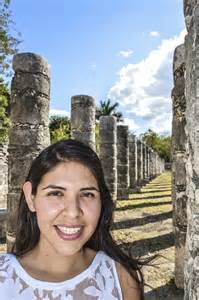What is the culture of Yucatan: Riviera Maya, Playa del Carmen, Cancun, Merida, etc?
Denis Larsen - Casa Hamaca Guesthouse
 There are, to me, three distinct cultures in the Yucatan:
There are, to me, three distinct cultures in the Yucatan: Cancun, the new development, the shiny, glossy bright stuff, which I almost know nothing about nor care too much about.
The Spanish / Hispanic culture that came to Yucatan roughly 475 years ago.
The Mayan culture, which has been here for perhaps 2,000 or 3,000 years.
The glitzy part doesn’t mingle with the...
 There are, to me, three distinct cultures in the Yucatan:
There are, to me, three distinct cultures in the Yucatan: Cancun, the new development, the shiny, glossy bright stuff, which I almost know nothing about nor care too much about.
The Spanish / Hispanic culture that came to Yucatan roughly 475 years ago.
The Mayan culture, which has been here for perhaps 2,000 or 3,000 years.
The glitzy part doesn’t mingle with the other parts very much.
I live in Valladolid. It is a Mayan city with a colonial overlay. I really like the mixture and the juxtaposition. When I go to the food market in the morning, almost everybody in the market speaks Mayan. They can speak Spanish as well, but to each other they speak Mayan. I know maybe 20 words of Mayan now. Every time I use a Mayan word they think it is really cute, but it makes me feel a little bit more part of the environment and the culture.
The Spanish part of Valladolid is the political part of it, and is based on the Spanish. In this town, I have never seen a picture of a mayor or met a mayor who is not fairly European looking. He may have Mayans working for him, but he’s almost always northern Spain or European in look. If you go to smaller towns, those people of European descent do not exist there, so everybody is Mayan, which means that they’re usually fairly short, brown, with black hair.
Valladolid was settled around 1543, on what became the ruins of a Mayan town. The Spaniards took apart the Mayan town or temples or whatever was here, and used them to start building the Spanish buildings. Within two years, the Mayans had the first revolt here in town, which was a regular thing up until the War of the Caste in the 1840s, when the Mayans, throughout the whole peninsula, rose against the Spanish because it was essentially an economy very much like Southern USA. The Mayans were not slaves, but they were indentured servants who bought things at the company store and had debt that they had to keep trying to pay off. As a result, there was a lot of resentment. They were treated as second-class citizens. They still are to a certain extent.
The War of the Caste lasted over 60 years. The peace treaty was signed either in the early 1910s, but there were still armed insurrection in Southern Campeche, near Belize, up until late 1930s.
The first time I went into some villages, I would get hard-looking stares from people because I was obviously an outsider coming into their town. Now, I don’t resent that as much as I used to. I understand it better why they’re looking at me that way. I’ve never had a problem, never felt threatened or anything like that. And once you get to know a Mayan, it just opens the world to you, and you only have to know one in the village, which opens that door.
We do a fair amount of what we call “food dispensas” every year, which is buying roughly $50 worth of food basics and household supplies, roughly a two-week supply for a family. My staff live in five different villages in Valladolid, so, depending on how many dispensas we have, they find two or three families in their town that are in need. They can be anyone from older people, people with medical problems, widows, or incapacitated people in one way or another. It has never been an issue or a problem to find somebody in need. And then we take the food and deliver it to them, along with Carlos who drives for me and speaks Mayan, because most of these people don’t speak Spanish or if they do, it is even worse than mine. So now in some villages they recognize car, the Carlos, and me. Now, people would rather wave at us than give us that look.
One of the nicest things I find about living in a town this size is when I go the market, and anywhere I go in town, I run into people I know. At the market this morning, we must have run into at least ten people who we greeted. A lot of people know me by my name: I’m Don Dennis. “Don” is an honorific, but it is not the same as being called “mister.” It has a lot more value than just being called mister; it is a sign of respect if they use that.
So I know that the chicken guy knows who I am, the pork guy knows who I am, the beef guy knows who I am, the fruit ladies know who I am, and the vegetable ladies know who I am. We talk and joke every time we go and it just feels good. It is probably very inefficient, shopping that way, but at the same time it keeps me in tuned with the people here and what’s happening and gives me fresh fruit.
(Guests from Casa Hamaca with Mayan villager for whom they have donated two weeks worth of food, pictured.)
Posted October 5, 2015
Gustavo Cisneros - Petén
 The culture of Yucatan is based on the Mayan culture. Mayans were great thinkers and were very creative. They are not warriors and that is their big difference from all the other people that were living in other parts of Mexico.
The culture of Yucatan is based on the Mayan culture. Mayans were great thinkers and were very creative. They are not warriors and that is their big difference from all the other people that were living in other parts of Mexico.There is a big difference in the Aztec culture (which was located north of Yucatan, more towards the center of present day Mexico) and the Mayan culture (which in Mexico, exists mostly in the Yucatan peninsula and surrounding areas). The Aztecs were the...
 The culture of Yucatan is based on the Mayan culture. Mayans were great thinkers and were very creative. They are not warriors and that is their big difference from all the other people that were living in other parts of Mexico.
The culture of Yucatan is based on the Mayan culture. Mayans were great thinkers and were very creative. They are not warriors and that is their big difference from all the other people that were living in other parts of Mexico.There is a big difference in the Aztec culture (which was located north of Yucatan, more towards the center of present day Mexico) and the Mayan culture (which in Mexico, exists mostly in the Yucatan peninsula and surrounding areas). The Aztecs were the ruling culture in Mexico. They were warriors so they were strong and they were hard workers. The Mayans are more intellectual people. They were not warriors but they were more inclined to creativity. That is the profile of these two cultures. The Mayan culture disappeared and it is one of the great mysteries. Their biggest cities were abandoned but at the end, the feeling that people get when they come here is the same as when the Mayans were here. Mayans were and are known to be intelligent and nice people and they like to live life. They are not as hard workers as the Aztecs. The same thing happened in most other countries like the south of the US, where it is more relaxed and the north is more industrialized with more hard working people. It could also be because of the conditions that we face such as the nice weather in the Yucatan, which makes people relax a bit more.
You can also see that the profile of the people who live in the Yucatan is somehow similar to the profile of the people who live in the Central America and in some parts of South America such as Peru and Colombia. They are similar in the way they act, behave, and interact with other people. To give you an example, given the distances and the problems with the roads prior to the revolution in 1910, most of the people used to go to La Habana (now Havana, the capital of Cuba), instead of going to Mexico City.
The Yucatan was also very rich due to the henequen (the sisal fiber that we have here in the area), which is also called “green gold.” Huge amounts of money and fortune were made out of haciendas exporting henequen. So people here in the Merida area in the state of Yucatan used to travel and spend around 6 months in Europe. They used to go to doctors in Cuba or travel to the States before going to Mexico City because it was hard for them to go to Mexico City. As a result, the culture here is completely different from the rest of the country. It gives the Yucatan a different feel. Even the gastronomy is completely different here. Within the country of Mexico, Yucatan is considered as paradise. It is a very nice place to live, very nice place to visit, and it has a very nice quality of living. I think one of the mistakes that we have done so far is that we have not promoted the Yucatan actively outside of Mexico. It would have been easy for us because most of the country of Mexico already knows that Yucatan is a nice place to live in or to visit.
The culture of Yucatan is very alive. You will find this in the ruins, which are incredible, and in the several elements in all the parts of Merida (the largest city in the Yucatan Peninsula, located in the state of Yucatan) that show you transition that this country experienced in so many ways. Just from the beginning, the type of the construction and buildings that the Spaniards brought, to the way emulated the French façades and the great buildings, which are really surprising. All these elements were brought into the society here. Merida was founded in 1542, so there are families that have been here for a very long time. They were very rich due to henequen. When you visit Yucatan, you will be very surprised to see all these elements together.
We now have the new elements, which are the modern parts of the city of Merida. We have a lot of shopping malls now and everything is now mixed together. That gives people a nice feeling when they visit.
(Depiction of ancient Mayan ruins in Tulum, Yucatan, Mexico by Frederick Catherwood, pictured.)
Posted February 18, 2016
Thomas Lloyd - Top Mexico Real Estate
 Merida is the hub and it is the oldest city in the Yucatan Peninsula. They have a lot of French influence, so when you see the homes or the haciendas there, they are incredible. You will find a lot of beautiful colonial homes in Merida. There are a lot of Americans who go down there to buy these older, run-down properties or structures, and they rebuild them. Merida has a nice regulation that the buildings downtown and in the zone, should not be torn down. You’re not allowed to...
Merida is the hub and it is the oldest city in the Yucatan Peninsula. They have a lot of French influence, so when you see the homes or the haciendas there, they are incredible. You will find a lot of beautiful colonial homes in Merida. There are a lot of Americans who go down there to buy these older, run-down properties or structures, and they rebuild them. Merida has a nice regulation that the buildings downtown and in the zone, should not be torn down. You’re not allowed to... Merida is the hub and it is the oldest city in the Yucatan Peninsula. They have a lot of French influence, so when you see the homes or the haciendas there, they are incredible. You will find a lot of beautiful colonial homes in Merida. There are a lot of Americans who go down there to buy these older, run-down properties or structures, and they rebuild them. Merida has a nice regulation that the buildings downtown and in the zone, should not be torn down. You’re not allowed to cover up the façade or the structures. They really want to protect the old culture and the architectural design of the place. It has done wonders to the downtown area. Going to Merida is like going to a town in the 1920s or the early 1900s.
Merida is the hub and it is the oldest city in the Yucatan Peninsula. They have a lot of French influence, so when you see the homes or the haciendas there, they are incredible. You will find a lot of beautiful colonial homes in Merida. There are a lot of Americans who go down there to buy these older, run-down properties or structures, and they rebuild them. Merida has a nice regulation that the buildings downtown and in the zone, should not be torn down. You’re not allowed to cover up the façade or the structures. They really want to protect the old culture and the architectural design of the place. It has done wonders to the downtown area. Going to Merida is like going to a town in the 1920s or the early 1900s. There are theaters here. We just went to the Nutcracker in a theater that was built in 1915 and it’s just amazing. Along with that, there is another three theaters that you’ll find in Merida. They just opened a museum featuring the Mayan culture and history. It’s a beautiful, brand new, participative museum for kids and adults.
Baseball and soccer are favorite pastimes of the people in Merida so there are a lot of baseball stadiums over there. Yachting is a big thing in Merida, too. A lot of families have their yachts or sailboats that they keep those in Progreso, which is only about 25 minutes away from Merida. There is also a Jack Nicklaus golf course in Merida and a community that is essentially living right there on the golf course. Everything keeps coming back to Merida, as it is the hub of the Yucatan. All the major universities have a school in the Merida zone.
Cancun, on the other hand, was only established in the 1970s, so it is a very new city. You will find about eighteen golf courses up and down the coast of the Riviera Maya. I talked to a gentleman recently who said, “You might not know about this Tom, but what’s unique about Cancun is that you have a Jack Nicklaus golf course here, a Nick Price golf course, a Robert Trent Jones golf course, and several other signatures golf courses and they are all open to the public.” So as a tourist or as someone who lives in Cancun, you can play on these courses. A lot of times in the States, such as in Florida, you are not allowed to play on these types of golf courses unless you are invited by one of the members. Here in Cancun, to play on these courses, you don’t need to be a member; you could just come off of the street and play golf.
The Mayan history here in the Yucatan is another big attraction. We have the Tulum Pyramid, which are the only pyramids in the Mayan civilization built right on the beach. They were built on the Tulum beach and are just amazing… postcard beautiful. It’s just beautiful to see these ruins overlooking the beach. Then, a lot of people haven’t heard about the Coba Pyramids, but that is one of my favorite locations. They make not just your typical pyramids that we are used to seeing. These are rounded pyramids. It is now one of the new Seven Wonders of the World and they receive an incredible amount of visitors every day.
Relevant to sports, Cancun has a professional soccer team that won the national championships around 3 years ago. Cancun also has a professional baseball team called Los Tigres that won the national championships in 2015. So for the sports fans who are retiring down here in Playa del Carmen, you would be only 40 minutes away from a beautiful stadium where you could watch soccer or baseball. The little league is a different league but kids have these soccer and baseball teams here, too. Soccer is all over the place. Nine out of ten kids here in Mexico play soccer.
A lot of people who retire here in Yucatan love participating in charity events such as helping Mayan kids. Most of the infrastructure is based on tourism like hotels in the cities like Playa del Carmen and Tulum but as you start going inland towards the west and you start to go into the jungles, you will find little villages populated with Mayan people. Many of the Americans who live here just love to help and raise some money for the Mayans. They get involved in activities that are geared towards helping the Mayans learn how to read and things of that sort. You can find that within 30 miles of Playa del Carmen.
We also have something very unique to the Yucatan Peninsula-- the cenotes. Cenotes are basically sink holes. The ground caves in and then water fills it so it looks like a beautiful pond with crystal clear Caribbean-colored water, which is just amazing. Tourists love to go to the cenotes when they want to cool down. They also love to go scuba diving and do other extreme sports in the cenotes. They explore these underground rivers, which connect one cenote to another. The place is just full of caverns.
(Stadium in Cancun, Mexico, pictured.)
Posted March 4, 2016
Iona Chamberlin - Hacienda San Pedro Nohpat
 The culture of Yucatan is that the people are very friendly. The Yucatecans don’t trust the Mexicans from other parts of Mexico maybe because some parts of Mexico are more violent than others.
The culture of Yucatan is that the people are very friendly. The Yucatecans don’t trust the Mexicans from other parts of Mexico maybe because some parts of Mexico are more violent than others. Yucatecan people consider themselves distinct in many ways maybe because of their language. Many Yucatecan people still speak Mayan, but the Mexicans in other parts of Mexico don’t. Yucatecan people see themselves in Yucatan in the same way Quebecers see...
 The culture of Yucatan is that the people are very friendly. The Yucatecans don’t trust the Mexicans from other parts of Mexico maybe because some parts of Mexico are more violent than others.
The culture of Yucatan is that the people are very friendly. The Yucatecans don’t trust the Mexicans from other parts of Mexico maybe because some parts of Mexico are more violent than others. Yucatecan people consider themselves distinct in many ways maybe because of their language. Many Yucatecan people still speak Mayan, but the Mexicans in other parts of Mexico don’t. Yucatecan people see themselves in Yucatan in the same way Quebecers see themselves in Canada- as being very distinct.
Most Yucatecan families, especially in rural areas, would rather build a fire on the ground and make tamales and tortillas the old fashioned way than use gas, and they still raise a few chickens and grow their own vegetables. Many of the Yucatecan families eat indigenous plants and use them in medicine, and they have their own kind of parties- their own way to have a wedding or a baptism. The family systems in the Yucatan are very strong and committed, and have been slower to catch up with modern times.
The Yucatecans are resistant to embrace modern culture and thus they maintain their traditional ways. It’s not like they couldn’t if they wanted to; they just choose not to. The younger generation is starting to embrace modern culture because of the Internet.
(Pictured: Yucatecan woman standing near ruins.)
Posted January 26, 2017
Roddrigo Sidney Whalesharkdaddy - Cancun Whale Shark Tours
Valladolid is a cultural GEM! Located half way between Cancun and Merida, Valladolid is a 450 year old Mayan masterpiece, safe and secure.
Life in Valladolid is "Muy tranquilo" !!! The locals are 90% Mayan and super friendly to all visitors and expats alike. The cost of Living is far below what you'll find in the resort hotspots of Cancun, Playa Del Carmen and even Tulum. Rent is very...
Valladolid is a cultural GEM! Located half way between Cancun and Merida, Valladolid is a 450 year old Mayan masterpiece, safe and secure.
Life in Valladolid is "Muy tranquilo" !!! The locals are 90% Mayan and super friendly to all visitors and expats alike. The cost of Living is far below what you'll find in the resort hotspots of Cancun, Playa Del Carmen and even Tulum. Rent is very affordable. Buying a house is easy, fast and much less expensive.
Valladolid has great shopping for fresh meats, fruits, and vegetables at the Centro Market place that hums with activity daily from 6 am to 2 pm. Almost everything you need is here plus great food stands serving the BEST of local Mayan foods, fresh local cheeses and seafood all in one spot. There are also bigger chains like Soriana, Chedraui and Aurrea Bodega. Taxis anywhere in town are just 25 pesos (about US $1.25) per trip.
Valladolid is just 2 hrs to either Merida or Cancun and just over an hour the "back way" to the beaches of Tulum. Rio Lagartos is 90 minutes north on the Gulf of Mexico. Valladolid has bus service anywhere via Mexico's great bus service from the central bus station downtown.
The main issue is that Valladolid is safe and secure. There is very little crime or cartel activity in Valladolid.
Valladolid has many great cenotes in the area and is only 45 minutes to Chichen Itza or "hidden gem" EK BALAM.
I've lived here 7 years & LOVE IT!
Posted April 29, 2018


